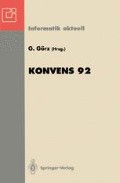Zusammenfassung
Zur syntaktischen Analyse koordinierter Strukturen wurden eine Reihe von Parserarchitekturen vorgeschlagen, die auf koordinationsspezifischen, vom Standardverarbeitungmodell des Parsers abweichenden Verarbeitungsmechanismen beruhen. Das KONCHA Modell stellt einen solchen Ansatz zur Analyse koordinierter Strukturen dar, bei dem darüberhinaus keine explizite grammatische Spezifikation vorausgesetzt werden. Es erweitert die zugrundegelegte Architektur eines aktiven Chartparsens um Koordinationsdämonen, die für die Behandlung der linguistisch kohärenten, ausschließlich syntaktisch determinierten Phänomenklassen der Konstituentenkoordination und der Linkstilgung verantwortlich sind. Die Koordinationsdämonen initieren während des Parseprozesses beim Auftreten einer koordinationsaktiven Konfiguration in der Chart neue Analyseprozesse. Diese haben die Form aktiver (Standard-) Kanten und multipel aktiver Kanten im Fall der Linkstilgung, wobei zur Interpretation der letzteren die fundamentale Regel des Chartparsens geeignet angepaßt wird.
Access this chapter
Tax calculation will be finalised at checkout
Purchases are for personal use only
Preview
Unable to display preview. Download preview PDF.
Literatur
Bran K. Boguraev . Recognising conjunctions within the ATN framework. In Karen Sparck-Jones, editor, Automatic Natural Language Parsing, pages 39–45. Ellis Horwood, 1983.
Veronica Dahl and Michael C. McCord. Treating coordination in logic grammars. American Journal of Computational Linguistics, 9(2):69–91, 1983.
Günther Görz. Strukturanalyse gesprochener Sprache. Addison Wesley, 1988.
Xiuming Huang. Dealing with conjunction in a machine translation environment. In Proc. 1st Meeting of European Chapter of ACL, pages 81–85, 1983.
Ronald M. Kaplan. A general syntactic processor. In R. Rustin, editor, Natural Language Processing, pages 193–242. Algorithmics Press, 1973.
Martin Kay. Algorithm Schemata and data structures in syntactic processing. Technical Report CSL-80-12, Xerox PARC, 1980.
Susumu Kuno. Gapping: A functional analysis. Linguistic Inquiry, 7:300–318, 1976.
Ewald Lang. Parallelismus als universelles Prinzip sekundärer Strukturbildung. In Ewald Lang, Gert Sauer, editors, Parallelismus und Ethymologie, pages 1–51. Berlin, 1987.
Carol Reize. A computational treatment of coordinate conjunctions. American Journal of Computational Linguistics, Microfiche(52): 1–44, 1976.
Ivan P. Sag, Gerald Gazdar, Thomas Wasow, and Steven Weisler. Coordination and how to distinguish categories. Natural Language and Linguistic Theory, 3:117–171, 1985.
Terry Winograd. Understanding Natural Language. Academic Press, 1972.
T. Winograd. Frame representations and the declarative/procedural controversy. In D.G. Bobrow, A.M. Collins, editor, Representation and Understanding: Studies in Cognitive Science, pages 185–210. Academic Press, 1975.
Terry Winograd. Language As A Cognitive Process Vol. I: Syntax. Addison Wesley, 1983.
William A. Woods. An experimental parsing system for transition network grammars. In R. Rustin, editor, Natural Language Processing, pages 111–154. Algorithmics Press, 1973.
Author information
Authors and Affiliations
Editor information
Editors and Affiliations
Rights and permissions
Copyright information
© 1992 Springer-Verlag Berlin Heidelberg
About this paper
Cite this paper
Haugeneder, H. (1992). Eine Parserarchitektur zur Verarbeitung koordinierter Strukturen. In: Görz, G. (eds) Konvens 92. Informatik aktuell. Springer, Berlin, Heidelberg. https://doi.org/10.1007/978-3-642-77809-4_20
Download citation
DOI: https://doi.org/10.1007/978-3-642-77809-4_20
Publisher Name: Springer, Berlin, Heidelberg
Print ISBN: 978-3-540-55959-7
Online ISBN: 978-3-642-77809-4
eBook Packages: Springer Book Archive

